While studying at UT, Patrick Hazari (’05) was on a traditional path with two top internships—at HOK in St. Louis, Missouri, and Skidmore, Owings & Merrill LLP in New York. After graduating from the College of Architecture and Design with one of the college’s highest honors, the American Institute of Architects’ Henry Adams Fund Certificate of Merit, he took a job as a designer with the prominent architectural firm of Weiss/Manfredi in New York.
Hazari’s first big project was the 198,000-square-foot multiuse building, Diana Center at Barnard College of Columbia University. “I realized quickly that it was OK to ask questions,” he said in his 2017 College of Architecture and Design commencement address. After three years, as the design work on the Diana Center was winding down and the project was moving into the construction phase, Hazari’s career took a nontraditional path.
The Friends of the High Line, a nonprofit conservancy that was building a 1.5-mile linear park on an abandoned, weed-covered elevated railroad track in New York City, was looking for a design and planning fellow. The fellow would help support construction of the first section of the park, running north from Gansevoort Street, three blocks below West 14th Street in Manhattan’s Meatpacking District, up through the Chelsea neighborhood to 20th Street. The position was for nine months. “I felt that it was important to look at this as an opportunity,” he said.
Hazari had grown up in a Knoxville household open to creativity. He was one of three children of Marcelle and Al Hazari, UT’s longtime director of the undergraduate chemistry labs, lecturer in chemistry, and innovative ambassador of his field of study.
“The design of the High Line itself is highly unique and nontraditional,” said Hazari. “Throughout the project, design played a key role in shaping the project. Design competitions were organized to solicit ideas from around the world. The winning design proposal by James Corner Field Operations (project lead), Diller Scofidio + Renfro, and Piet Oudolf envisioned a simple walkway with plantings that were inspired by the wild landscape that took root on High Line when it was abandoned. Their proposal posed a simple question: ‘What will grow here?’”
 The West Side Line had been built in the 1930s to move goods in and out of the warehouse and factory districts of Manhattan’s Lower West Side and abandoned in 1980. City officials were urging that it be torn down as an eyesore and a safety hazard. But creative minds had a different idea. Why not turn it into an elevated walking trail? Fashion designer Diane von Furstenberg, whose offices were in the Meatpacking District, and her husband, movie mogul Barry Diller, were major backers. They also hosted some of the first fundraisers. Construction on Section 1 took place in 2006.
The West Side Line had been built in the 1930s to move goods in and out of the warehouse and factory districts of Manhattan’s Lower West Side and abandoned in 1980. City officials were urging that it be torn down as an eyesore and a safety hazard. But creative minds had a different idea. Why not turn it into an elevated walking trail? Fashion designer Diane von Furstenberg, whose offices were in the Meatpacking District, and her husband, movie mogul Barry Diller, were major backers. They also hosted some of the first fundraisers. Construction on Section 1 took place in 2006.
Hazari oversaw the completion of Section 1, which opened in 2009, and after the nine-month fellowship turned into a full-time position, he oversaw the design of Section 2 between 20th and 30th streets, which opened in 2011. He also art directed and edited the 160-page book, Designing the High Line: Gansevoort Street to 30th Street, filled with renderings, maps, architectural drawings, and photos of the track’s construction in the 1930s, its abandonment after 1980, and its ongoing reconstruction.
In 2012, as manager of design and capital projects, Hazari led the design and construction of the High Line Maintenance and Operations Headquarters facility and the next year earned a promotion to director of design and construction in time for the construction of Section 3, which opened in 2014.
Section 3 resembles a horseshoe built atop the still-active MTA-LIRR rail yards that circle around newly developed Hudson Yards. The High Line swings west on 30th Street from 10th Avenue toward the Hudson River, turns north up 12th Avenue to 34th Street and then east to 11th Avenue, where it descends into a street-level grove of Aspen trees on 34th Street, for which Hazari led the concept design. He also developed the final phase, a spur that extends east on 30th street to 10th Avenue into Hudson Yards that opened in June 2019.
“From a design perspective,” said Hazari in his commencement address, “the High Line established a new park typology that rethinks what it means to be a park in an urban setting. From a city planning standpoint, a once-industrial area was transformed into a vibrant space. The linear nature of the High Line itself literally stitches three neighborhoods together. It has provided a new way to see and experience the city. As a project, the High Line has elevated the discussion of the importance of public space and community engagement.”
 The High Line draws more than eight million visitors a year. Hazari is now leading the design of a street-level plaza at 18th Street that will feature a new stair and elevator to the High Line that will break ground in early 2020. In addition, Hazari oversees the capital repair and maintenance program for the High Line.
The High Line draws more than eight million visitors a year. Hazari is now leading the design of a street-level plaza at 18th Street that will feature a new stair and elevator to the High Line that will break ground in early 2020. In addition, Hazari oversees the capital repair and maintenance program for the High Line.
For the past eight years, he has served as a guest critic at many prominent schools of design. He also provides valuable insight at UT. Hazari has been a member of the College of Architecture and Design’s Board of Advisors and a member of the Dean’s Advocacy Board.
In September 2017, UT honored him with an Alumni Promise Award, which recognizes alumni who have demonstrated distinctive achievement early in their careers. While on campus, Hazari visited with faculty and staff and worked one-on-one with students critiquing their designs.
“Patrick is a source of inspiration for current and future students,” said College of Architecture and Design Dean Scott Poole, “helping them imagine the possibilities for their own careers and future success.”
 When asked for advice, Hazari explained, “It’s important that students know the profession blurs many lines, and there are different professional paths that can be taken within the field of design. The curriculum at UT prepares and exposes students to the big picture. Architecture is just a small piece of the fabric of design.”
When asked for advice, Hazari explained, “It’s important that students know the profession blurs many lines, and there are different professional paths that can be taken within the field of design. The curriculum at UT prepares and exposes students to the big picture. Architecture is just a small piece of the fabric of design.”
“My job has opened the door for me to work as an architect in a nontraditional way,” Hazari said in his commencement address. “The work I do allows me to play different roles that are largely the result of the varied and complex nature of the High Line itself. I see myself as part advocate, part negotiator, part community organizer, part politician, and definitely part architect. I work with representatives of the parks department, city planning, the mayor’s office, as well as donors, real estate developers, board members, contractors, architects, landscape architects—the list goes on and on.
“By working with a diverse project team that relies on or works with architects, I’ve seen how design thinking can impact and shape our built environment and communities in many ways. Design thinking gives you the skillset and ability to observe, synthesize information, see beauty and develop form, listen and offer solutions, more important, the ability to be innovative.”
Photography by Liz Ligon and Timothy Schenck.

